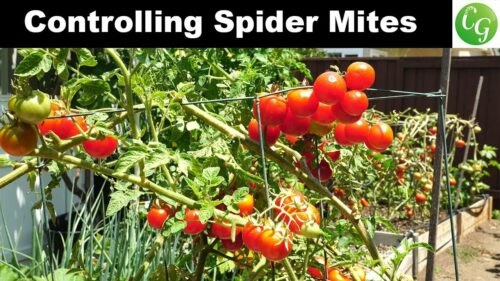Spider Mites On Tomato Plants. Tomatoes are one of the most common ingredients. They’re useful for improving the flavor of salads.
Stews, roasts, and other types of dishes. For this reason, many are growing them right at home.
Growing tomatoes isn’t necessarily a difficult job.

It’s a plant that only needs constant attention and weeding. However, many fail to grow this plant.
One pest continues to worry seasoned and beginner tomato growers alike – spider mites.
So how to get rid of spider mites on tomato plants?
I’ll let you in on some of the best methods in this article.
How Do Spider Mites Infest Tomato Plants?
Spider mites infest tomato plants in juvenile form, larvae form, and egg form.
Mites come from grasses, flowers, and other plants outdoors.
Wind can take spider mites and transfer them to other plants.
Animals, such as dogs, cats, and birds, can do the same too.
And sometimes, even owners can transfer spider mites to their tomatoes after going to a garden or any other similar place.
How To Get Rid of Spider Mites?
Use Neem Oil
The neem oil is an organic insecticide that comes from neem tree seed extract.
Neem oil has a peculiarly strong garlicky or nutty aroma.
It contains a lot of Azadirachtin, which serves as natural repellant pests.
Upon application, neem oil poisons the spider mites and stops them from reproducing.
It further provides a thin protective layer for the tomato plant so that the mites won’t feed on its leaves.
It’s best to dilute neem oil with a bit of water before application.
Don’t pour the neem oil or water it on the tomato plant.
Use a sprayer to apply evenly.
Put Natural Insect Killers To The Tomato Plants
You can also seek the aid of green lacewings and ladybugs to kill spider mites.
Green lacewings and ladybugs are beneficial because they feed on pests.
Using these insects against pests is a common strategy among organic tomato farms.
Eggs of ladybugs and green lacewings are sold online.
You’ll find most on platforms such as Amazon, eBay, Alibaba, and online insect websites.
You can make the tomato plants attract ladybugs and green lacewings if buying isn’t an option.
What you have to do is put several water-filled old glass and bowls near the tomatoes.
Free the tomato garden from ants, and uncover the tomato plants’ leaves.
On a side note, you might also want to stop using insecticides.
These will discourage the ladybugs and green lacewings from visiting.
Sourness Can Also Work.
Spider mites don’t like acidic conditions.
Adjusting the ph condition of your tomato garden to -3 or -4 can eradicate them.
For doing this, you can water your tomato plants with diluted vinegar now and then.
You can also use lemon juice if you’re afraid that vinegar might hinder the growth of tomato plants.
You can also use ph decreasing soil pellets.
However, remember not to put too much on the soil as this might have adverse effects.
About a fistful will do ensure that the soil, where the tomato plants are growing, stays well fertilized.
Use Horticultural Oils.
You can also use horticultural oils to make a horticultural oil insect spray.
Don’t confuse neem oil with horticultural oil because both are different.
Horticultural oil is derived from plants or petroleum.
Neem oil on the other hand is sourced through organic means only.
An advantage of horticultural oils is that you can make them yourself.
Common ingredients are cottonseed oil, safflower oil, soybean oil, or vegetable oil.
The effects of horticultural oil are nearly the same as neem oil.
But they’re a better option if you find neem oil odoriferous.
Use horticultural oil if you don’t want a violating smell in your tomato garden.
Ending Takeaways.
Other sources say that getting rid of spider mites can be done by picking.
I don’t approve of this method.
Picking is a very counterproductive solution to spider mite infestation.
Just imagine it, 10 or 20 spider mites can be on each tomato plant leaf.
So if you have 10, you’ll be picking about a hundred or more.
The spider mites will eventually come back after you got rid of them via the methods that I taught.
Be sure to prevent this scenario.
To do so, you might want to plant insect-repelling plants such as cilantro.
Chinese parsley, spring onions, garlic, and chrysanthemum.
